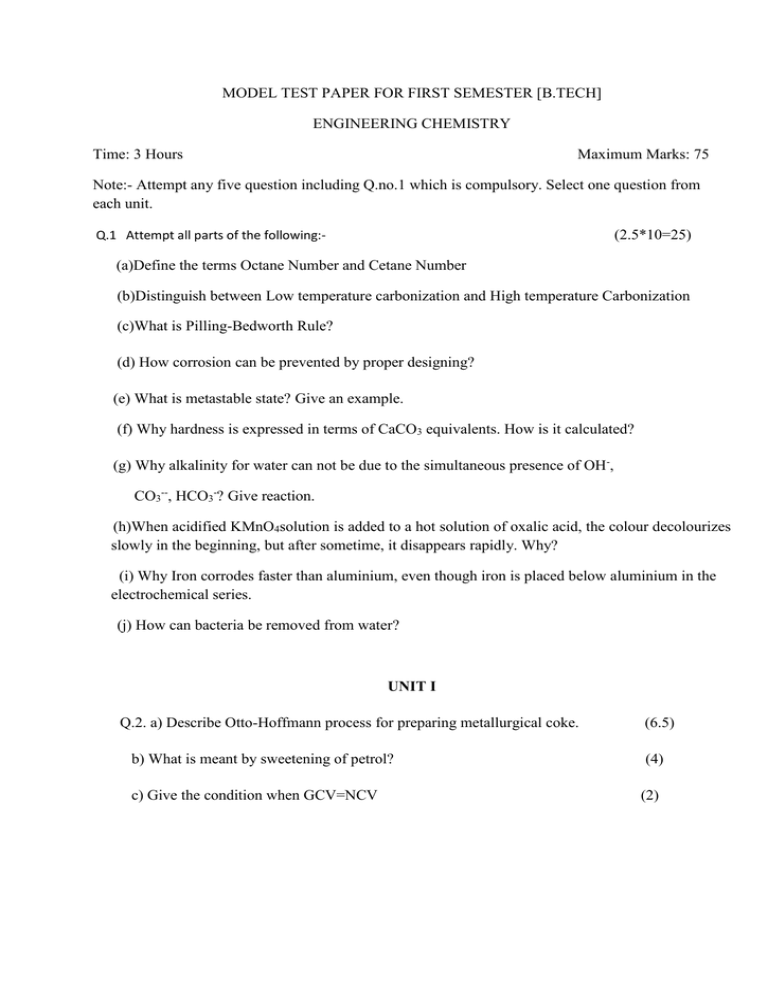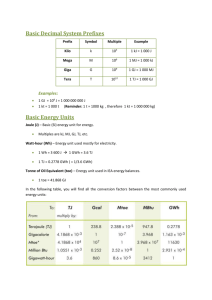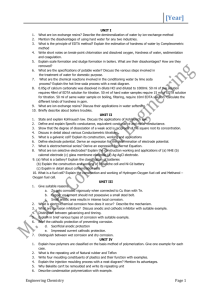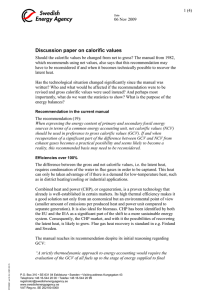Applied Chemistry - Chemistry Model Papers
advertisement

MODEL TEST PAPER FOR FIRST SEMESTER [B.TECH] ENGINEERING CHEMISTRY Time: 3 Hours Maximum Marks: 75 Note:- Attempt any five question including Q.no.1 which is compulsory. Select one question from each unit. Q.1 Attempt all parts of the following:- (2.5*10=25) (a)Define the terms Octane Number and Cetane Number (b)Distinguish between Low temperature carbonization and High temperature Carbonization (c)What is Pilling-Bedworth Rule? (d) How corrosion can be prevented by proper designing? (e) What is metastable state? Give an example. (f) Why hardness is expressed in terms of CaCO3 equivalents. How is it calculated? (g) Why alkalinity for water can not be due to the simultaneous presence of OH-, CO3--, HCO3-? Give reaction. (h)When acidified KMnO4solution is added to a hot solution of oxalic acid, the colour decolourizes slowly in the beginning, but after sometime, it disappears rapidly. Why? (i) Why Iron corrodes faster than aluminium, even though iron is placed below aluminium in the electrochemical series. (j) How can bacteria be removed from water? UNIT I Q.2. a) Describe Otto-Hoffmann process for preparing metallurgical coke. (6.5) b) What is meant by sweetening of petrol? (4) c) Give the condition when GCV=NCV (2) OR Q.3 (a) A boiler is fired with a coal having the following composition; C= 75%, H= 9%, S= 2%, O=4%, N=3% and ash content= 7%. Calculate: (6.5) (i) GCV and NCV of 1kg of coal (ii) Minimum theoretical air required for combustion of 1kg of coal (iii) Percentage composition of dry flue gases if 25% excess air is used (b) A coal has following composition by weight C=80%, O2= 5%, S=2.5%, N=1.4%, ash=2.1. Net calorific value of the coal was found to be 9430 K cal/Kg. Calculate the percentage of Hydrogen and higher calorific value. UNIT II Q.4. a) Write a short note on catalysis by metal salts (Wilkinson’s catalyst). b) Discuss the kinetics of heterogeneous catalysis. (3.5) (5) c) What are enzymes? Describe the chemical conversions catalyzed by the following enzymes: Diastase, Maltase, Invertase, Urease, Ptyalin. (4) OR Q.5 a) Draw and explain the phase diagram of lead-silver system and discuss an application of this system. (4.5) b) What is the difference between critical point and triple point. (4) c) Mention the advantages and disadvantages of phase rule. (4) . UNIT III Q.6 a) How is Calgon conditioning better than phosphate conditioning? (4.5) b) Explain why NH3-NH4Cl buffer is added during the determination of hardness of water by EDTA method? (3) c) 100 ml of water sample, on titration with N/50 H2SO4 using phenolphthalein as indicator, gave the end point when 5 ml of acid were run down. Another 5 ml of the acid is required to obtain methyl-orange end point. What type of alkalinity is present in the sample and what is its magnitude? (5) OR Q. 7. a) What is the principle of EDTA titration? Briefly describe the estimation of hardness of water by EDTA method. (6) b) Calculate the amount of lime (88.3% pure) and soda (99.2% pure) required for softening 24000 litres of water per day for a year containing the following: CaCO3= 1.85 mg/l, MgSO4 = 0.90 mg/l, CaSO4 = 0.34 mg/l, MgCO3 = 0.42 mg/l, MgCl2 = 0.76 mg/l, SiO2 = 2.3 mg/l, NaCl = 2.34 mg/l. (6.5) UNIT IV Q.8 (a) Define Corrosion. Explain the mechanism of dry corrosion. How the extent of corrosion can be decided by the nature of corroded product? (6.5) (b) Describe the mechanism of wet corrosion in detail. (6) OR Q.9 (a) Write short notes on:- (6.5) (i) Sacrificial anodic protection (ii) Tinning (iii) Electroplating (iv) Impressed current cathodic protection (b) Explain the term “passivity”. How does the rate of corrosion depend upon the relative areas of anode and cathode? Explain (6) MODEL TEST PAPER FOR FIRST SEMESTER [B.TECH] ENGINEERING CHEMISTRY Time: 3 Hours Maximum Marks: 75 Note:- Attempt any five question including Q.no.1 which is compulsory. Select one question from each unit. Q.1 Attempt all parts of the following:- (2.5*10=25) (a)What is knocking? Define octane number and cetane number. (b) Why net calorific value(NCV) less than gross calorific value(GCV)? (c) How is galvanisation different from cathodic protection? (d) (e) What will happened, if we do not remove silica from boiler feed water? (f) What is the role of inhibitor in catalyst? (g) Explain why good fuel for petrol engine is a bad fuel for diesel engine. (h) (j) UNIT I Q.2. a) Describe Otto-Hoffmann process for preparing metallurgical coke. (6) b) What is meant by sweetening of petrol? (3) c) Give the condition when GCV=NCV (3.5) OR Q.3 (a) A boiler is fired with a coal having the following composition; C= 75%, H= 9%, S= 2%, O=4%, N=3% and ash content= 7%. Calculate: (6.5) (i) GCV and NCV of 1kg of coal (ii) Minimum theoretical air required for combustion of 1kg of coal (iii) Percentage composition of dry flue gases if 25% excess air is used (b) A gaseous fuel has the following composition by volume. (6) H2= 36%, CH4=6%, CO= 4%, O2= 16% and the rest are nitrogen. If 30% excess air is used, find the air actually supplied per m3 of the fuel and the composition of the dry flue gases. UNIT II Q.4. a) Write a short note on catalysis by metal salts (Wilkinson’s catalyst). b) Discuss the kinetics of heterogeneous catalysis. (3.5) (5) c) What are enzymes? Describe the chemical conversions catalyzed by the following enzymes: Diastase, Maltase, Invertase, Urease, Ptyalin. (4) OR Q.5 a) Draw and explain the phase diagram of lead-silver system and discuss an application of this system. (4.5) b) What is the difference between critical point and triple point. (4) c) Mention the advantages and disadvantages of phase rule. (4) . UNIT III Q.6 a) How is Calgon conditioning better than phosphate conditioning? (3.5) b) Explain why NH3-NH4Cl buffer is added during the determination of hardness of water by EDTA method? c) 100 ml of water sample, on titration with N/50 H2SO4 using phenolphthalein as (3) indicator, gave the end point when 5 ml of acid were run down. Another 5 ml of the acid is required to obtain methyl-orange end point. What type of alkalinity is present in the sample and what is its magnitude? (6) OR Q. 7. a) What is the principle of EDTA titration? Briefly describe the estimation of hardness of water by EDTA method. (6) b) Calculate the amount of lime (88.3% pure) and soda (99.2% pure) required for softening 24000 litres of water per day for a year containing the following: CaCO3= 1.85 mg/l, MgSO4 = 0.90 mg/l, CaSO4 = 0.34 mg/l, MgCO3 = 0.42 mg/l, MgCl2 = 0.76 mg/l, SiO2 = 2.3 mg/l, NaCl = 2.34 mg/l. (6.5) UNIT IV Q.8 (a) Define Corrosion. Explain the mechanism of dry corrosion. How the extent of corrosion can be decided by the nature of corroded product? (6.5) (b) Describe the mechanism of wet corrosion in detail. (6) OR Q.9 (a) Write short notes on:- (6.5) (i) Sacrificial anodic protection (ii) Tinning (iii) Electroplating (iv) Impressed current cathodic protection (b) Explain the term “passivity”. What are the factor which affect corrosion? (6)






